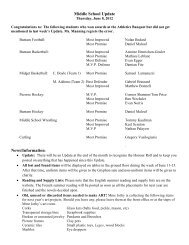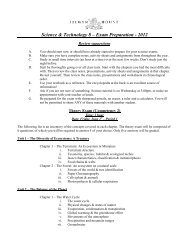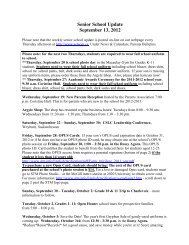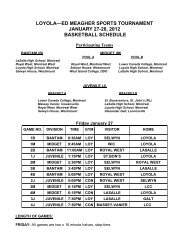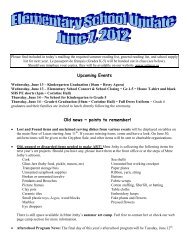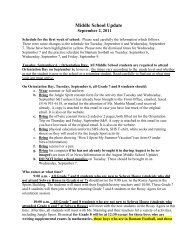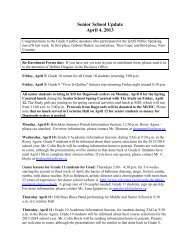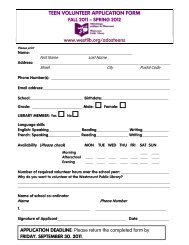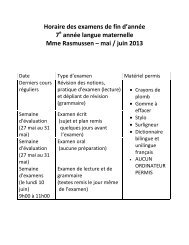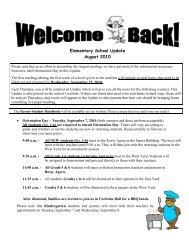GRADE 8 STUDY GUIDE
GRADE 8 STUDY GUIDE
GRADE 8 STUDY GUIDE
You also want an ePaper? Increase the reach of your titles
YUMPU automatically turns print PDFs into web optimized ePapers that Google loves.
<strong>GRADE</strong> 8 <strong>STUDY</strong> <strong>GUIDE</strong><br />
OUTLINE OF EXAMS<br />
Your math examination will occur in two parts. The first part will be a situational problem (C1) during<br />
the assessment week between May 27 th and May 31 st . The second part will be a 2.5‐hour long formal<br />
assessment of your mathematical reasoning (C2) will be on Tuesday, June 4 from 9:00‐11:30.<br />
For both evaluations, you will be required to bring a pencil, an eraser, a ruler and a scientific calculator.<br />
Sharing equipment is not permitted.<br />
You are entitled to a one‐page memory aid for both evaluations. You may use both sides of an 8.5” x 11”<br />
sheet of paper, but you must write by hand.<br />
<strong>GUIDE</strong>LINES FOR <strong>STUDY</strong>ING<br />
You will receive a package consisting of blank copies of every unit test that you have written. Re‐writing<br />
these tests will be a good way of preparing for your final evaluations.<br />
You will also receive a practice exam which you are to complete on your own time and which will be<br />
reviewed in class.<br />
You should be reviewing any notes posted in the conference on First Class as well as consulting the<br />
material available to you on Math Help Services.<br />
The following is a list of every topic that we have covered over the course of the year. All of these<br />
topics may potentially be evaluated on both parts of the examination.<br />
Topic 1: Fractions and Decimals<br />
1. Fractions:<br />
a. LCM and GCF<br />
b. Add<br />
c. Subtract<br />
d. Multiply<br />
e. Divide<br />
f. Exponents<br />
g. BEDMAS<br />
h. Division rules<br />
2. Decimals:<br />
a. Fractions to Decimals<br />
b. Decimals to Fractions, including repeating decimals<br />
3. Problems with fractions and decimals
Topic 2: Exponents<br />
1. The meaning of an exponent<br />
2. Exponential/ Factored/ Standard form<br />
3. Prime Factorization<br />
4. Exponent Rules:<br />
a. Zero exponent<br />
b. Negative exponents<br />
c. Product of powers<br />
d. Quotient of Powers<br />
e. And any combination of the above<br />
5. Scientific Notation<br />
Topic 3: Polynomials<br />
1. Definition of a polynomial and its parts<br />
a. Coefficient<br />
b. Literal Coefficient<br />
c. Constant<br />
d. Term<br />
e. Variable<br />
f. Degree<br />
2. Degree of a polynomial<br />
3. Collecting like terms<br />
4. Polynomial names<br />
a. Monomial<br />
b. Binomial<br />
c. Trinomial<br />
5. Multiplying Polynomials<br />
a. Distributive Property<br />
b. FOIL<br />
6. Division of Polynomials<br />
a. Poly by Monomial<br />
b. Poly by Binomial<br />
7. Combinations of the above
Topic 4: Algebra<br />
1. Equations vs. Expressions<br />
2. Solving single variable equations:<br />
a. 1 to 4 step equations<br />
b. Rational equations<br />
c. Equations involving a variable with degree of 2<br />
3. Literal Equations: Isolating a variable<br />
Topic 5: Algebraic Word Problems<br />
4. Converting:<br />
a. Words to Expressions<br />
b. Expression to Words<br />
5. Number Problems<br />
6. Shape Problems<br />
7. Rate/Time/Work Problems<br />
8. Money Problems<br />
9. Speed/Time/Distance Problems<br />
10. Age Problems<br />
Topic 6: Ratios, Rates and Percents<br />
1. Problems involving Ratios<br />
2. Problems involving Rates<br />
3. Percents<br />
a. Converting between fractions, decimals and percents<br />
b. Solving percent problems<br />
c. Calculating taxes, discounts and making bills<br />
d. Percent increase and decrease problems<br />
e. Simple Interest (I = Prt)<br />
f. Commission problems
Topic 7: Angles, Polygons and Circles<br />
1. Identifying the different types of angles<br />
a. Acute<br />
b. Obtuse<br />
c. Reflex<br />
d. Right<br />
e. Complementary<br />
f. Supplementary<br />
2. Parallel Line Theory<br />
a. Interior alternate<br />
b. Exterior alternate<br />
c. Interior same side<br />
d. Corresponding<br />
e. Opposite angles<br />
f. Using these theories to find missing angles<br />
3. Polygons up to 12 sides<br />
a. Definition<br />
b. Names<br />
c. Sum of interior angles<br />
d. Area<br />
i. Including complex shapes, made up of combinations of polygons and circles<br />
e. Perimeter<br />
i. Including complex shapes, made up of combinations of polygons and circles<br />
4. Pythagorean Theorem<br />
a. Finding missing side of a right triangle<br />
b. Word problems involving<br />
5. Circles<br />
a. Parts of<br />
b. Circumference<br />
c. Area<br />
d. Arc length<br />
e. Sector area<br />
f. Problems involving all the above<br />
Topic 8: Surface Area and Volume<br />
1. Calculate the surface area and volume for Prisms, Pyramids, Cylinders and Cones<br />
2. Calculate the surface area and volume for combinations of the above shapes



